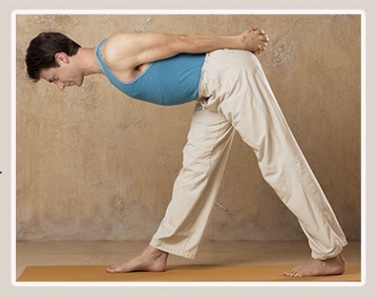Parshvottanasana, the lateral extension, is a standing posture that finds its way into the repertoire of almost every yoga student. Lengthening the torso over one leg and bending forward from the hip joints awakens an intense stretch in the deep muscles of the gluteal region as well as in the hamstrings, and dramatically strengthens the lower back. Parshvottanasana also improves balance and isolates the movement of the pelvis from that of the upper torso. It is a posture with such a rich variety of benefits that it shouldn’t be ignored.
Parshvottanasana is a member of the family of postures that stretch the external hip rotators (the muscles that Charlie Chaplin used to turn his feet out when he walked). Tight hip rotators, especially the piriformis muscle, can lead to serious lower back and leg problems. But when the hip rotators are regularly stretched, these problems can be avoided. The key to success in the pose lies in correctly aligning the hips and maintaining a stable lower back as you bend forward over the extended leg. Let’s take a closer look.
Setting up the legs and hips to perform parshvottanasana requires care. While you can move into the pose in a number of ways, try beginning in the mountain pose, with the feet hip-width apart and parallel. Notice the natural alignment of the two sides of the pelvis—both are facing forward. Now step the right leg back one generous step and turn the right heel in for balance. Clasp your hands behind you and look down at your hips. If the right hip has also moved back (along with the leg), you’ll see that the pelvis no longer faces forward. This alteration in alignment will spoil the pose. To correct it, bring the right hip forward until the two hips are aligned once more. In the process, make any minor adjustments to the spacing between your feet that you feel necessary. This prepares you for the forward bend.
Forward bending from the hip joints creates deep creases along the lines that divide the thighs from the pelvis. In a normal standing posture, you can feel these creases with your fingertips as they appear and disappear when you walk in place. Bending forward from the waist or lower back, rather than from the hip joints, does not produce these creases. So the next clue to performing parshvottanasana is to maintain a flat back from the base of the spine to the crown of the head as you initiate the forward bend. Like the spoke of a wheel, gravity will bring your torso over the left leg. It’s not necessary to bend very far. You will recognize the distinctive crease at the top of the thigh, and both your back and hips will maintain their alignment. As a result, you’ll feel deep stretches in the buttock, hip, and back of the leg.
In this pose, it is the hip joint that acts as the hub of the wheel around which the torso is rotated. The structure nearest that hub is the pelvis itself. Thus, hamstring muscles, attached to the sit bones, and hip rotators, attached to the sacrum, are both stretched when the pelvis is rotated forward around the hip joints. (The sitting bones and sacrum move back and up while the front of the hips move forward and down.) So long as the hips remain aligned and the back remains flat, parshvottanasana can do its work.
A few more tips will help to refine the pose. As you prepare to bend forward, interlace the fingers and straighten the arms, drawing the shoulder blades toward one another in the back. Draw the shoulders down and away from the ears. Lengthen the neck so that it is an extension of the spine. Maintain a long, straight back as you bend forward from the hip joints. This will automatically engage the hamstrings and piriformis muscles. As you bend forward, focus your gaze softly on the floor in front of your foot. Breathe evenly and smoothly.
You can move in and out of the posture a number of times with the breath. Then hold the pose for 5 to 10 breaths before repeating on the other side.
While it has many benefits, the intensity of parshvottanasana can be counterproductive, freezing mobility in the pelvis. To ease off a little, you can face a wall as you perform the pose, placing your hands on the wall to sustain balance while working a little less deeply in the bend. To extend further toward the floor, place your hands on blocks on either side of the leg. There are many variations of parshvottanasana, but the version described here is the essential practice—one that will not disappoint you if you want to maintain the health of your hip joints and lower back.
Caution: Rounding the lower back can destabilize the spine and lead to spinal injury.
Source: Yoga International JANUARY 28, 2015
See more articles from Luke Ketterhagen by joining Yoga International
https://yogainternational.com/
- Luke Ketterhagen's blog
- Log in or register to post comments


